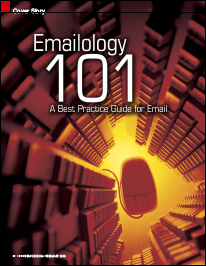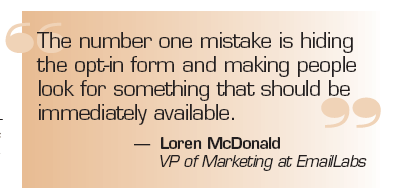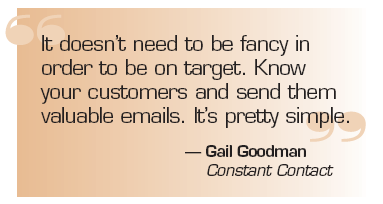Emailology

Friends and colleagues, reports on the death of email have been greatly exaggerated. This statement in no way should indicate that email marketing is flourishing unabated. There are challenges which cannot be ignored, barriers which cannot be broken down and new technologies which may very well threaten its very existence. But you are reading this article because people (that means you and everyone you know) use email daily and most rely on it as their primary means of communication, others as their primary mode of marketing. That alone makes email a core component of successful Web promotions.
| If you are interested in marketing your products, services or viewpoints to an existing client base or prospects through email or are simply interested in improving how your email promotions work then becoming an expert in "Emailology" is necessary. |  |
Email "Delivers" for Web Businesses
The reason that most online enterprises utilize email marketing is because of its immediacy, its versatility and its cost. The positive financial rewards of using email as a marketing tool are well proven and easily expressed. As a result, traditional advertisers and startups alike are now using email to market at the individual level through customized pitches targeting their consumer's specific preferences.
Thanks to the growth of high-speed Internet access and some advanced personalization technologies, Web-based businesses have been able to reach more consumers with more messages that incorporate dynamic appeals. According to a Forrester Research study of 137 online retailers, on average, consumers open emails at a rate of about 33% and an average order rate of 4.3%. With open-to-sale ratios on that level it is easy to understand why marketers use email, and if you are not, why you should be using it. While your company brand may not be as well known as more established companies, many experts agree that there is enough value in email marketing for any size enterprise to engage in the practice regularly.
Email Marketing - Best Practice
Now that we realize that email can indeed work to promote a product and generate sales, it is important in our Emailology study that we develop a firm understanding of the characteristics of great email marketing campaigns. Amidst an increasingly difficult deliverability environment, legislative barriers and consumer distaste, delivery rates continue to rise indicating that companies are getting better at the practice of email marketing. In our study of Emailology we look at what most email marketers consider to be of greatest importance: list acquisition, building trust, campaign timing, creative, open-rates and deliverability.
List Acquisition:
Certainly the most overlooked (and often the most challenging aspect - both ethically and monetarily) of effective email promotions for marketers is developing and building a permission-based email list that works. Sure, you could purchase or build an email spider and crawl every single site on the Web and get millions of addresses to which you could send promotional messages - and many marketers do just that. The problem is that sending unsolicited messages results in exceedingly poor conversion rates because you cannot guarantee that any of the recipients are interested in your message. If that were not enough to deter you from mass crawling and bulk emailing, chances are excellent (if you are working from one IP address) that your ISP (Internet Service Provider) will find out and block or simply dump any future messages you send - not just promotional emails.

This is precisely the reason you see so many websites featuring high profile sections of their landing pages dedicated to promoting their email campaigns (newsletters, announcements and promotions). In fact, those that frequently boast of success with email marketing campaigns typically have one thing in common - the presence of sign-up opportunities across each page of their site via forms. Email marketers that highlight the benefits of subscribing or incentives to subscribe fare much better than those that do not. Incentives could range from special reports to free downloads and are limited only by the creativity of the offer and the relativity of that offer to the subscriber or prospect. For example, a site about gardening may want to offer a free report on the best time to plant certain vegetables but not a report on how to refurbish a 1952 Black Vincent Lightning motorcycle.
While many email marketers build their own in-house lists, others choose to use third party mailing or partner lists. If you are acquiring lists (through direct purchase or via co-registration) there are several best vetting practices by which you should abide - starting with verifying the source of all names on an acquired list. According to Deirdre Baird, CEO and President of Pivotal Veracity, "avoiding appended names (recipients) that did not opt-in directly to the source and ensuring that there was a separate affirmative consent opt-in for third party offers can make all the difference in reducing spam complaints from recipients and the ISP you are using." In addition, successful email marketers that purchase lists or use co-registration practices to acquire new recipients find that asking whether those companies clarify that "opt-out" permits opt-out to all offers from the source (and not just your offer) makes a positive impact on open rates and revenue from email promotions.
Building Trust With Prospects/Subscribers:
If your aim is building a list where recipients are actually interested in specific offerings, then those recipient's permission is vital. To get that permission initially it is immensely important that you express why you are an enterprise trustworthy enough to handle their email address. This can be done by outlining your affiliations and providing detailed contact information about the enterprise behind the site.
Earning subscriber trust goes beyond just sharing contact information and being open about your existing affiliations. Brandon Milford, Director of Marketing for IntelliContact says that "building trust with your subscribers begins before someone signs up for your newsletter." Milford suggests that by clearly stating on your website the types of messages your subscribers can expect to receive (along with how often they will receive them) will enable prospective consumers to trust you more rapidly; essential in the fast paced world of the Web.
In addition, revealing how you intend to use that information once it is in your control is of supreme importance to those who are on the fence about subscribing. Believe it or not, people do read site privacy policies so within a subscription request form, provide a brief statement about how you handle email addresses (e.g. we never rent, sell, share or trade your email address) along with a link to more detailed information within a corporate privacy policy.
While it is true that few email marketers make extensive efforts to build trust with prospective consumers, there are resources available which help businesses convey their trustworthiness to prospective subscribers, including TrustE, BBBonline and ValidatedSite. While these companies do not monitor the sending or receiving of email to gauge how trustworthy an enterprise is they do provide verification that the company sending the email are who they claim - something often overlooked but nonetheless exceedingly important should a consumer ever wish to formally unsubscribe, register a complaint or
express their gratitude.
The Power Of Email Creative:
There is no denying that successful email promotions rely in great part on the quality and integrity of your list. But campaigns which produce positive results also rely on the power of the email creative - text (copy) and images. A 2005 report from Jupiter Research/ IPSOS survey of consumer recipients on which creative components prompted them to open and respond to messages revealed that 54% cited the products or services featured, followed by written copy (40%), the subject line (35%) and compelling offers such as discounts or free shipping (33%). The power of the creative, therefore, along with the relevance of the content to the recipient drives most consumer clicks on email messages rather than the graphical elements it contains alone.
A quick search will yield millions of suggestions related to refining email creative. Most tips and tactics revolve around making specific calls to action in the copy and stating clearly the point of the email in the subject line. Advanced personalization techniques take email creative much further and allow email marketers to customize individual mailings based on the needs of the recipients. Thanks to technologies which enable the targeting of specific users based on demographics and psychographics more marketers are expected to adopt these approaches and integrate these creative solutions within their email marketing campaigns.

Email Campaign Timing:
Getting the best response from an email marketing campaign requires not just timing (as is often thought) but also an understanding of when customers and prospects are looking at your site. Brandon Milford, Director of Marketing for IntelliContact suggests sending business to business emails Tuesday through Thursday. "We've found that the best times of day to send are just after the start of the day around 9:30 am or just after lunch around 1:30 pm. It is best to avoid sending business to business emails after 4pm or on weekends," said Milford, continuing "we recommend sending business to consumer emails either between 5pm and 8pm Tuesday through Thursday or between Friday evening and Sunday afternoon.”
Ask many other marketing agencies the same question and you will receive the same standard "Tuesday through Thursday during the day" response. While this in many cases is a good guide, it will not work in every instance. The reason is that people read their emails at different times, typically before or after they access your site. Take for instance a free online gaming site. Peak traffic times may be between 3pm and 9pm - when "tweens" are at home and surfing the Web. Loren McDonald, VP of Marketing at EmailLabs suggests understanding the traffic at your website to understand how people use your site and when an email communication will be most effective.
Click-To-Open-Rates
Open rates and click-through rates (the most commonly used email metrics) provide marketers with basic insights into how an email message performed. The Click-To-Open Rate (CTOR) conversely combines these two metrics and offers additional metrics to analyze and benchmark performance of individual mailings. (Note: open rate is defined as "messages opened (deliverability) and click-through rate is the number of clicks (visits) generated from message delivered).
"Click-To-Open Rate is simply the ratio of unique clicks as a percentage of unique opens," says Loren McDonald, VP of Marketing at EmailLabs. The CTOR measures how effective your email message was in motivating recipients who opened it and clicked a link indicating the percentage of messages opened, instead of the number of messages delivered alone.
(Table illustrating Click-To-Open-Rates - courtesy of EmailLabs)
Many marketers use the Click-To-Open Rate as a tool to assess the actual deliverability of their email messages. The Click-To-Open-Rate table from EmailLabs reveals the CTOR across ISPs. The CTOR in many instances can reveal potential issues or deliverability trends that need to be addressed. For instance, the "E-commerce Email" CTOR for the AOL domain is clearly out of line with the rest of the ISP/domains. The clickthrough rate of 8.2% is not far below the average for the message, but the open rate is well below the average suggesting that the open rate for the AOL segment is much higher.
As you can see in the EmailLabs research, the CTOR varied very little, 25%-27% (excluding Earthlink), while open and click-through rates varied widely. In this case, regardless of ISP (again excluding Earthlink), about one-fourth of recipients who opened the newsletter also clicked on a link. So despite wide variances in open and click-through rates, this message actually motivated most all recipient segments to click at the same rate.
Challenges to Deliverability:
Defining deliverability accurately is about as possible as it is to achieve a COTR of 100%. With as many email marketing variables as there are possible recipients in the Web universe, deliverability in its simplest explanation means getting the emails you create into the inbox of your subscribers - without getting blocked by the ISPs or placed in a bulk folder along the way. Across all ISPs monitored by Pivotal Veracity between October and December of 2005, delivery metrics for emailers was 84.4% Inbox, 5.6% Bulk Folder and 10.0% were missing. (Table illustrating deliverability statistics by selected ISPs)
Deirdre Baird of Pivotal Veracity suggests that while "the goal is to achieve 100% inbox delivery, these stats show that even legitimate mailers sending requested emails to their own customers, deliverability is a big challenge." For mailers who fail to properly opt-in their customers or fail to treat those customers with respect (i.e. mail them relevant content on an appropriate frequency), inbox deliverability rates are even less.
If you are concerned about your email deliverability there are many steps you can take - including cleaning your list and determining if any "email creative" obstacles (non-compliant HTML, blocked interactive elements, image stripping) are preventing delivery from the vantage point of the ISP. "Given the importance email plays in both servicing one's customers (e.g. order confirmations) as well as driving revenue from customers, deliverability is a critical issue to which all mailers must pay attention to," said Baird.
As you may have guessed, email relies in great part on the integrity of your technical system. This is why many email marketers are protecting their domain's authenticity by adding SPF text records to their DNS. More receiving mail servers (read ISP's) are looking to see if the sending server's IP address is on record before passing the email through to the recipient. Without one standard protocol, marketers are increasingly employing multiple protocols in order to increase deliverability. Since deliverability and authentication are such important topics and this article is limited in space, Website Services has added an online supplement to deliverability on its website.
By The Way…Will RSS Kill Email?
Real Simple Syndication (RSS) presents a mild threat to email marketing as it is an immensely efficient way to keep clients informed on priority news and events. While RSS will not kill email, it may have to adapt. "RSS and email are very complementary communication tools. Even if someone subscribes to your RSS feed, you will still want to use email marketing at key moments to make sure your readership stays engaged." said Gail Goodman of Constant Contact.
Outsourced Email Offers Reliability, Savings and Scalability
Many online enterprises are outsourcing their email marketing campaigns as opposed to keeping it in-house. The reason many are doing so is to save time and enhance security and reliability as outsourced solutions place the responsibility of maintaining and managing the email infrastructure in the hands of a trusted email hosting partner such as EmailLabs, IntelliContact or Constant Contact.
Many businesses continue to build or buy in-house mail servers in the interest of protecting their correspondence. Unless the server is properly maintained and configured, an in-house server may offer less security than a managed outsourced solution - putting at risk not just the emails you send but the bottom line of your online business. Outsourced email marketing solutions on the other hand offer a managed hosting solution that provides enterprise class reliability.
Most online enterprises continue with an ad-hoc approach to their email marketing using development tools and email clients as they were not originally intended. The failures of these campaigns and the companies that manage them is why outsourcing email marketing campaigns are such an appealing option for Web businesses. Effective campaigns require resources that small companies do not ordinarily have; a highly trained, dedicated in-house staff that manages the various components of email efforts (including designers, copywriters, database experts, reporting analysts and teams to manage relations with ISPs). Thanks to the legal and creative challenges that email marketers are presented with you have two options - become an expert or hire one and outsource your email promotions.
The Future of Email Marketing: 2006 and Beyond
What most people want to know is what lies ahead for Email marketing. Online marketing broke all records in 2005 - in many respects thanks to email. With all signs pointing to 2006 as the biggest year yet for Web business, email marketing will most likely also see increases as more consumers use email as their primary means of communication online. This means increased competition for email marketers and as in all highly competitive markets only the fittest will survive. The fittest being those that understand Emailology and the components of successful email marketing - primarily list acquisition, personalization, timing and deliverability.
Marketers using irregular, disparate email campaigns would be wise to focus on a more consumer-centric and comprehensive approach to customer management and segmentation. Those marketers who excel will utilize email to extend the lifetime value of their existing customer base. Thanks in many respects to the technological advances in email marketing, customers are evolving from one-time buyers to loyal shoppers which means a greater responsibility on the part of email marketers to treat them as the valuable components of business that they are.
So what is the future of email marketing? Email marketers will increasingly be driven by the timeless direct marketing objective: Deliver the right promotion to the right consumer at the right time. In the end, it really is that simple.
Written By Pete Prestipino,
Managing Editor of Website Services Magazine.










